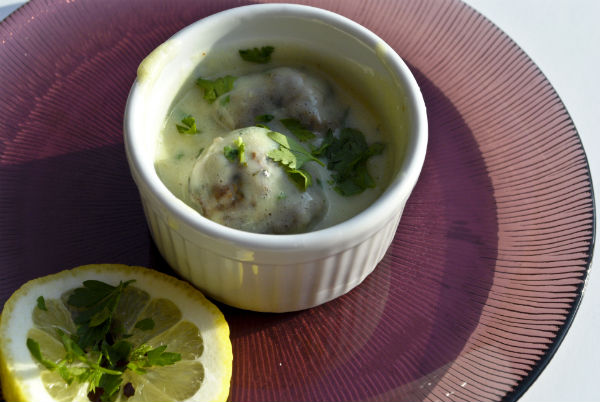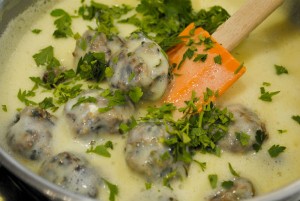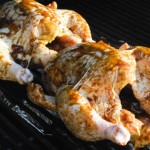While we are on the subject of Huevo Limon for Passover, Nona also made a Huevo Limon soup called Agristada. I was asking my sister Carole about it and she said it is her favorite comfort food to this day.
The creamy looking lemon soup reveals little parsley and ground beef meat balls floating just beneath the surface. This may be an acquired taste but once initiated it is delicious.
To make this lemony soup you need:
1 pound of ground chuck meat
2/3 cup chopped parsley
2 eggs
½ cup matzo meal
Salt and pepper
Then:
1 and ½ cups cold water
2 eggs
1 egg yolk
1 tablespoon matzo cake meal
Juice from 1.5 to2 lemons (depending on how juicy they are and your taste)
Salt and Pepper

Combine the ground chuck, parsley, eggs, and matzo meal in a mixing bowl. Season the meat ball mix with salt and pepper to you taste. Roll little round meat balls in your hands and place them on a sheet of waxed paper. Heat a non stick skillet and cook the meatballs until they are seared golden on the outside and cooked through. Set them aside while you prepare the soup.
Beat the eggs with the egg yolk in a small bowl. Add the lemon juice and then the cake meal and whisk until smooth. Bring the cold water to boil in a large saucepan. Take 2 tablespoons of the boiling water and add it to the bowl with the eggs and lemon. Whisk rapidly to heat the eggs with the hot water. Add two more tablespoons of boiling water, whisk again. Next add the eggs and lemon right back into the boiling water and whisk to heat. Do not let the water, egg, lemon mixture come to a boil. Keep whisking while it simmers and it will become thick and smooth… Do not boil. Add the cooked meatballs to the soup and season with salt and pepper. Serve with chopped parsley sprinkled on top.
I don’t think I would serve this to a large crowd since it is tricky. Make it for yourself for lunch or when you have no guests. Enjoy your little secret treat.







Hi Linda, I am a such a big fan of the egg and lemon sauce! The meat balls with egg and lemon sauce is one of my favorite dishes, so glad you posted this recipe, we make it slightly differently but I’ll be trying your version today. Thank you for sharing your recipes, gorgeous photos and stories with us Linda. I wish you and your family a very happy and sweet Passover.
I’ve never tried this recipe (either making it or eating it), but after reading this, my curiosity has definitely been piqued, and so I think I just might try to make it sooner rather than later. As always, you’ve inspired me. Wishing you and your family, and Megi and Norma and your families, and everyone else who’s a regular Boreka Diary enthusiast a very joyous Passover.
Hi Linda,
Thank you for the wonderful Passover Recipes you posted. I am looking forward to trying this recipe as well as the leek and potato kuftes later this week. I have always made the leek kuftes with meat–this variation sounds very good.
Wishing you and your family, Greek Girl , Megi and all your readers a very Happy and Healthy Passover.
Dear Linda, I made your agristada recipe yesterday and we loved it. It was absolutely delicious, thank you so much for sharing.
I wish you, Norma, Greek Girl and your families a very happy, healthy and joyous Passover.
Hi Linda,
I made the agristada recipe today and it came out great. My family loved it. They want it year round. Another winner from your blog!!!!
Thank you for sharing .
Norma
My grandma used to do agristada without the kofte, meat balls.I never liked it as a child but now I wan tto do for my Ashkenaz hubby and his family !!! do you also have recipe for burmuelos and lajadas? Those 2 were my favorite in my childhood during pesah.
My gandma was a” frying”expert her burmuelos were always so puffy and delicious and not oily at all, I miss eating them.
thanks for your blos, it brings back all childhood memories
Hi Susan, I think I posted a Passover burmuelo recipe on the site, check the recipe index or here is the link . Please tell me what lajadas are? Did you mean lechettas? Best regards Linda
My question is about the agristada and it following kashrut. I am not Jewish myself, so I don’t know the exact rule, but I was under the impression that dairy and meat couldn’t used in the same meal. Am I incorrect?
Hi Roy, your comment intrigues me. Yes dairy and meat may not be eaten together, in my kitchen, we have separate plates, separate dish washers, separate cutlery, and separate pots and pans, I even have a separate dairy shelf in the refrigerator. In a newly redone kitchen it is possible to have separate sinks. I do not serve an evening meat meal on the same tablecloth I served the toast with butter on in the morning. There is no dairy in the Agristada recipe unless you are referring to the eggs. Eggs are not considered dairy for this separation. Eggs are part of a neutral category called Parave, which includes fish, vegetables, and fruit, vegetable oils, legumes (beans, lentils). Parave for the most part may be mixed with dairy or meat, except traditionally we do not mix meat and fish and do not serve them together on the same plate. They may however, be consumed at the same meal i.e. a fish starter course. I hope this helps you to understand kashrut a little better. It can be very confusing. I am glad you are reading my blog. My first book, a baking book, should be out in November!
Linda,
Thank you for the reply! Kashrut is something that certainly is hard to understand for someone with no Jewish heritage. Yes, you were correct about my thinking that the eggs would be the dairy in the dish. I am a culinary student at a local college and am creating a cuisine project that encompasses Jewish cooking. The Agristada recipe sounds delicious and possibly something that I may try to make myself, but I definitely wanted to include it into my project. My instructor is an executive chef himself, so I’m sure that he may know a thing or two about Jewish eating habits and recipes. I just didn’t want to include anything that might not be correct as I would like my project to be perfect. I really do appreciate your assistance and hope that you don’t mind that I’m using your recipe. As I become more of a culinarian myself, I think that your blog may be a wonderful place to start. I also have a question about what the most commonly used cooking method and what the most common spices used in Jewish cooking are. Any feedback is greatly appreciated.